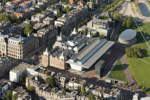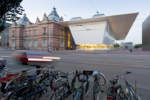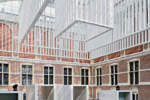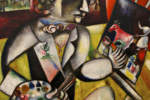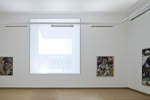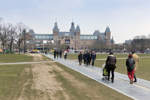Entering the Stedelijk Museum in Amsterdam means to walk through the new wing designed by the Dutch Benthem and Crouwel firm, also known as “the bathtub”, a large white volume whose soft and rounded forms really remind of a big tub, placed by the old brick building from 1895 by Adriaan Willem Weissman, and which lies in the museum complex, next to the Van Gogh Museum and a stone’s throw from the Rijksmuseum, both of which have been subject of expansion and renovation.
Despite the provocative and provoking form of the addition, principally intended for temporary exhibitions, which has triggered discussions and debates among critics and historians and which in any case intrigues and fascinates the visitors, the museum, which is already famous for its permanent collection, features a “traditional” visit itinerary in its old rooms, where the works arranged in a sequence along the walls comprise masterpieces by Karel Appel, Paul Cézanne, Theo van Doesburg, Jean Dubuffet and some works by Marc Chagall. A small canvas by the latter is to be found in a corner, almost as if to keep a low profile; it is a matter of Autoportrait aux sept doigts from 1912. This fascinating self-portrait,a lot could be said about the painter’s “seven fingers”, may be understood as a metaphor on art, on the work of the artist, his personal condition and role in society; it is a masterpiece capable of expressing, in a synthetic and fascinating way, the relationship between the author, the painting, the place where it is exhibited and, last but not least, the person gazing at it. The painter shows the artist while he is working on a painting. Three places are featured, or rather painstakingly described: the first, which one sees from the window, makes one understand where the author of the work finds himself in that moment; the second is drawn in a cartoon at the top right and represents what he is “thinking”, that is to say the place he remembers and which serves as source of inspiration for the painting he is working on; the third is the painting he is painting, which is taking form on the canvas.
The three scenarios that are represented are completely different from one another, there is no relation between them, even if each seems to be the cause of the other: the artist does not remember and does not want to represent the place where he lives, the one he sees, but something impressed in his memory. Perhaps he is motivated by the fact that he finds himself in another city, and wants to transmit, to evoke the other place in his work. Still, the work he is producing and which is taking form on the canvas is not identical to the one he remembers; it is not a reproduction of the latter. In addition to these three places we have to add the one in which the painting is on show, which has to be added to the ones described by the author; it is the place in which the observer encounters the work and in which he learns of the condition of the person who has conceived and painted that work, and it may condition his judgment.
As we know, memory is not a reminiscence of a past reality; it is not a memory that is faithful to the experiences we go through, but rather what remains of an event, the emotions it leaves, the impression we are left with. Chagall’s self-portrait therefore tells the story of the artist’s ability to use memory in a creative way, conscious that nothing is what it has really been, but everything is the way it sediments and is consolidated as experience. As illustrated by this painting, to communicate memory, to transmit it and show it to others is not synonymous with rendering an immobile appearance of a memory, but to try to express its meaning, its significance, mixed with other similar ones, through manners and instruments that belong to the sphere of emotions rather than to perception. If we accept this hypothesis, those who have to exhibit a work of art, who are in charge of displaying and diffusing it, cannot only base their actions on the substance of the work – physically, materially, figuratively and morphologically – but on what it will be able to evoke, to tell and to inspire. Every work of art, on a par with the madeleine of Proustian memory, superimposes the artist’s experience on the individual and intimate ones of every user; it mixes the memories of the places it describes with the place in which it is installed, uniting the time when it was created with the reality in which it is perceived today; in short, museums, galleries and exhibitions are not dusty deposits of faded memories but, rather, unimaginable crossroads of emotions.
In fact, the user contributes with his or her knowledge, culture and sensations to give the work, which would otherwise have no reason to exist, its full significance; in particular, it justifies its inclusion in a certain environmental context that allows it to come into contact with others. The contemporary culture has acknowledged that art acts as permanent collective memory, and that museums represents “showcases” in which one may exhibit, rather than conserve, the live traces of its own history. But the society in which we live has, as is often the case, to some extend carried these attitudes to art to extremes, to the point of considering some works as true “star masterpieces”, indispensable icons, myths that must perforce be admired, on a par with the work of some artists who are by now considered as the very image of a certain historical or cultural period.
These “stars” in the artistic firmament, these works, are wanted and demanded by a vast part of society, including people who do not ordinarily visit museums, and this is undermining the correct and normal relationship between the work of art, the user and the place in which it is exhibited. For these rare masterpieces every consideration on the correct way to install a work is thwarted by normally inconceivable crowds, with queues and numbers of spectators that alter every predictable relationship between space and art. Leonardo da Vinci’s Mona Lisa by Leonardo da Vinci has already for some years been on show in an enormous room in the Louvre; it is submerged every day by visitors who, after having passed distractedly before other masterpieces of humanity, are willing to queue for hours to remain before it a few seconds, pushed by the queue behind them, to admire the enigmatic portrait. Analogously, Rembrandt’s Night watch stands out alone, enormous, in a dedicated room in the Rijksmuseum, as does Picasso’s Guernica for which a wholly autonomous installation has been prepared in the Reina Sofia Museum of Madrid.
These works are more and more solitary, separated from the collections and from the vicinity of others by the same author or period, deprived of references or comparisons, to be exposed, sometimes disrespectfully, to the view of unimaginable crowds, irrespectively of their size, motif or content. The solitude of these works is expressed by the multitude of users who are unlikely to have the time to listen to the slow-paced story of memories which every work tells. It has recently appeared in the news that the MoMA intends to relocate Yoshio Taniguchi’s project because the structure, which opened as recently as in 2004, can no longer withstand the quantity of visitors, perhaps attracted by Picasso’s Les demoiselles d'Avignon or Mondrian’s Broadway Boogie-Woogie.
All this must make us reconsider consolidated exhibition criteria; museum design cannot ignore the values of what they will contain. And even more importantly, the decisions cannot be taken without considering the principles of flexibility and changeability necessary to adapt to changes in taste and demands on the part of the public. To an increasing extent, the criteria of museum design, the concepts of arrangement and display, consolidated museology, must consider criteria of installation, usually used for temporary events, of communication and, last but not least, of marketing and promotion of culture which allows the institutions to speculate on the image of the assets and works they possess.
In any case, the spectacularization of art, of some authors or works, has also led to an opposite trend, made necessary by the inalienable need for diffusion and fruition on an ampler scale, which has resulted in temporary exhibitions as the itinerant interactive exhibition Van Gogh Alive or the one which is currently enjoying great success with the public in Naples: The Impossible Exhibition. The latter is an exhibition of full-size, digital and backlit reproductions of all the works of masters as Raphael, Leonardo, Caravaggio, seen one next to the other, removed from their context and presented in an orderly sequence, as if in a realistic slideshow with the only difference that the user participates actively in the event, carried along in a kind of travel in time and space. This must make one reflect on the possibilities offered by digital techniques today, on the users’ willingness to interact with virtual reality and information technology. The borders between copy and original, between real and virtual are evidently becoming blurred. But, above all, the expectations are higher, the demands and requirements of those who want to experience art are more specific and defined.
This is influencing the inherent criteria of exhibition design, while the principles of museum planning, and the architecture of the museum itself, require longer times of adaptation.
To understand what the museums of tomorrow should be like means to accept the criticism levied by Norwegian architect Sverre Fehn years ago, namely that a museum is only a “dance of dead objects”, an exhibition of cold witnesses that are distant and immobile in time, unless these “things” are able to move among human beings, walk with them, enter their lives, interact with the users in their present time; in other words, that the museum is able to render “intelligible that which cannot be seen”, the meaning of “things”, the memory of the past.



